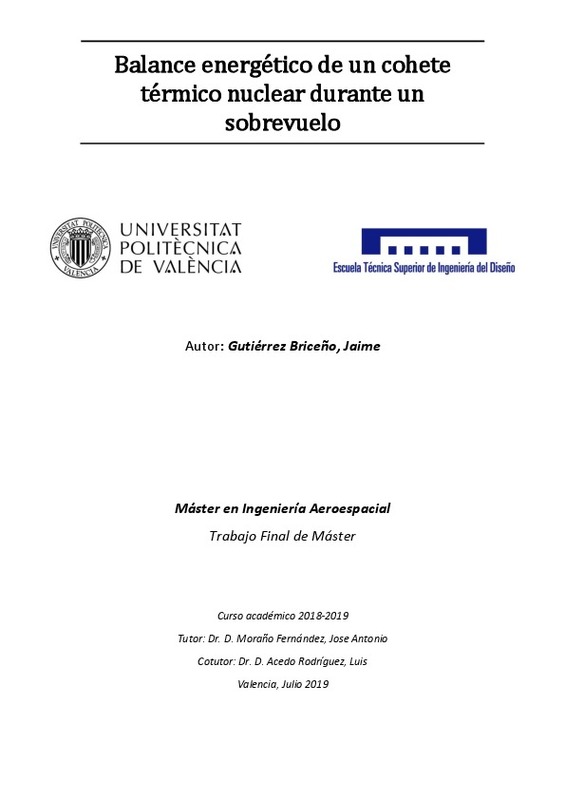|
Resumen:
|
[EN] The present work is based on the modelization of two different and already existing ideas. On one hand the maneuver of the Flybys. This technique is used in almost all the interplanetary missions, based on using the ...[+]
[EN] The present work is based on the modelization of two different and already existing ideas. On one hand the maneuver of the Flybys. This technique is used in almost all the interplanetary missions, based on using the big bodies gravity to gain a speed boost without any fuel consuption. On the other hand, is a project carried out in the last sixties. The NERVA project is one of the most important studies about thermal nuclear rockets existing, getting to a point of building and testing real models.
The construction of the model is based on the integration of a fictional probe during its trayectory on a flyby. In addition to this, an impulse of one thermal nuclear rocked from the project is added using the Tsiolkovsky ecuation. In order to do that, we first integrate the actual trayectory of the Pioneer11 during its flyby, and later on we simulate the power on of the engines.
The following study is based on improving the outter speed of the fictional probe. For that, the better point of power on of the engines is located on the periapsis of the orbit. At this point the probe has the maximun speed, and from this point the probe will go against the Planet´s gravity, trying to pull away from it. The passing altitue is another variable. With all this factor in consider, the fictional probe can reach up to 8 times the speed of a normal flyby, gaining access to a heavy time reduced kind of missions.
[-]
[ES] Este trabajo se basa en la modelización de la unión de dos ideas ya existentes. La primera es la maniobra de un sobrevuelo. Esta maniobra es la técnica esencial en todas las misiones interplanetarias, basada en impulsar ...[+]
[ES] Este trabajo se basa en la modelización de la unión de dos ideas ya existentes. La primera es la maniobra de un sobrevuelo. Esta maniobra es la técnica esencial en todas las misiones interplanetarias, basada en impulsar gravitacionalmente las sondas espaciales sin ningún gasto de combustible. La segunda es un proyecto llevado a cabo en los años sesenta. El proyecto NERVA realizó el estudio más importante hasta la fecha sobre los cohetes térmicos nucleares, construyendo y obteniendo sus especificaciones experimentalmente.
La modelización consiste en integrar mediante el problema de los tres cuerpos una órbita ficticia que realiza un sobrevuelo y al que se le aplica un impulso térmico nuclear de un motor tipo NERVA. Para ello se integra primero el sobrevuelo de la sonsa Pioneer11 alrededor de Saturno y a través de la ecuación de Tsiolkovsky se añade el efecto del encendido de motores.
El estudio del modelo se basa en obtener la máxima velocidad de salida posible para así optimizar el vuelo ficticio. Esto se consigue encendiendo los motores en el periapsis de la órbita, momento en el cual la sonda tiene la máxima velocidad y momento a partir del cual la gravedad del planeta sobrevolado comienza a actuar en contra. La variación de la altura de paso es otro factor influyente. Con todo, se consiguen velocidades de salida de hasta 183 km/s, una velocidad de hasta 8 veces superior a las de un sobrevuelo clásico.
[-]
|







